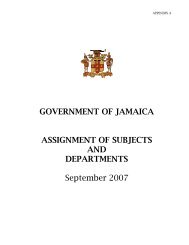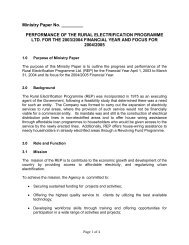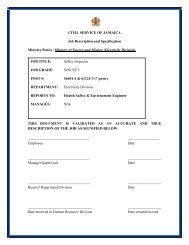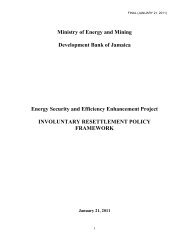Jamaica Biofuels Report - Ministry of Energy
Jamaica Biofuels Report - Ministry of Energy
Jamaica Biofuels Report - Ministry of Energy
Create successful ePaper yourself
Turn your PDF publications into a flip-book with our unique Google optimized e-Paper software.
form methyl esters. The caloric value <strong>of</strong> the esters is approximately 10% less than traditionaldiesel fuel and the fuel has a variety <strong>of</strong> other advantages and disadvantages, including lowercombustion emissions (except NOx), and shorter storage life. A by-product is crude glycerol(about 10 percent <strong>of</strong> the product volume; 80 per cent purity), worth 10 US cents per gallon orless, currently, due to a worldwide glut created by already ongoing biodiesel production.The <strong>Jamaica</strong>n market for biodiesel has several segments. A national plan currently underconsideration calls for B-5 blends, analogous to the E-10 ethanol mandate, and PetrojamLimited has elected to adopt US standards for fuel composition and testing and has undertakenindependent evaluations <strong>of</strong> engine performance on biodiesel blends. Based on information atthe PCJ web site 11 , total fuel consumption for road and rail transport was 5.8 million barrels in2008. Of this about 4.3 million barrels was unleaded gasoline, leaving 1.5 million barrels (63million gallons) <strong>of</strong> diesel, which represents a nationwide market <strong>of</strong> roughly 3 million gallons peryear <strong>of</strong> plant methyl esters for B-5. This small volume may not justify a national campaign tointroduce the blend, but an advantage would lie in the contribution <strong>of</strong> the plant esters to fuellubricity, which is more difficult to achieve at 15 ppm sulfur levels projected for three yearsfrom now.Another alternative market sector would be truck fleets, which could consume B-100. Dieseltrucks represent nearly 90 percent <strong>of</strong> the 20,727 diesel vehicles on the island and no doubt ahigher percentage <strong>of</strong> the fuel consumption. If a number <strong>of</strong> large fleet operators were to convertto B-100, as a trash collector has apparently proposed, biodiesel could displace a larger fraction<strong>of</strong> the 63 million gallons than the 5 percent upper limit <strong>of</strong> B-5.Stationary engines represent an even larger market. Just over 6 million barrels (252 milliongallons) <strong>of</strong> petroleum, including heavy fuel oil and auto diesel, are consumed for electricitygeneration. Assuming the 2.4 million barrels <strong>of</strong> auto diesel remaining after subtractingtransport fuel from total production is for power generation that would represent 100 milliongallons per year <strong>of</strong> potential market for B-100 for stationary diesel engines and combustionturbines. Biodiesel could also displace bunker fuel, but the value would be reduced.In any case, the August 19, 2010 price <strong>of</strong> auto diesel at the Petrojam refinery gate was $95.86US per barrel, or $2.28 per gallon. Accounting for the 10 percent lower calorific value, theequivalent value <strong>of</strong> biodiesel would be $2.05 per gallon.Electric PowerSugarcane processing can contribute renewable electric power through cogeneration fueled bybagasse. Power sales to the electric utility can defray production costs, and the utility systemsaves on fuel, at a minimum and possibly generating capacity and power transmission costs,depending on location and timing considerations.11http://www.pcj.com/dnn/Statisticsbyproduct/tabid/144/Default.aspx,33










